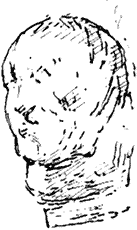
THESE CARVED HEADS have been in place at the foot of the window arches in the Chantry Chapel, Wakefield, since 1848 but they appear to me to be much older than that. The whole of the building above road level was rebuilt by Gilbert Scott and today only the extended bridge pier on which the chapel stands is of original medieval construction. It is one of only three remaining Chantry Chapels built on bridges in Britain.
Two carved heads at either side of the main east window are identified as being part of Scott’s restoration and they’re far fresher than their 12 counterparts (6 on each side) on the windows of the nave.
If they are from the original construction were these heads from the inside or the outside of the chapel?
Perhaps they would have been no more than worn stubs had they been subject to 500 years of weathering on the outside, prior to the Victorian restoration, but photographs of the original chapel front, which was rebuilt in a local park (and destroyed by vandals about 10 years ago) show that the medieval carvings had survived in recognisable condition.
Water under the bridge
I had thought that I’d visited the chapel on one previous occasion over 25 years ago, but I’m not so sure now as my image of the interior has always been of a dark place. You enter through a stone frontage and I think that gave me the impression of a dark, secluded space behind but because of those seven windows it’s actually light and airy and you’re aware of the sound rushing water over the weir.
 The
place that I would have liked to visit today, when the Chapel has been
opened as part of Heritage Open Days 2007, is the one remaining medieval
room, incorporated into the extended bridge pier. It’s small, perhaps
8 feet on its longest dimension, and the priest would have used it to
put on his robes.
The
place that I would have liked to visit today, when the Chapel has been
opened as part of Heritage Open Days 2007, is the one remaining medieval
room, incorporated into the extended bridge pier. It’s small, perhaps
8 feet on its longest dimension, and the priest would have used it to
put on his robes.
The narrow oak door to the steps that take you down to it has a sign on it today: ‘Please do not enter as because of recent flooding the floor may be covered in mud and silt.’
Some
day I hope I’ll get to take a look at this unremarkable room
because really that’s the one genuinely medieval space that remains
from the 14th century Chantry Chapel.


